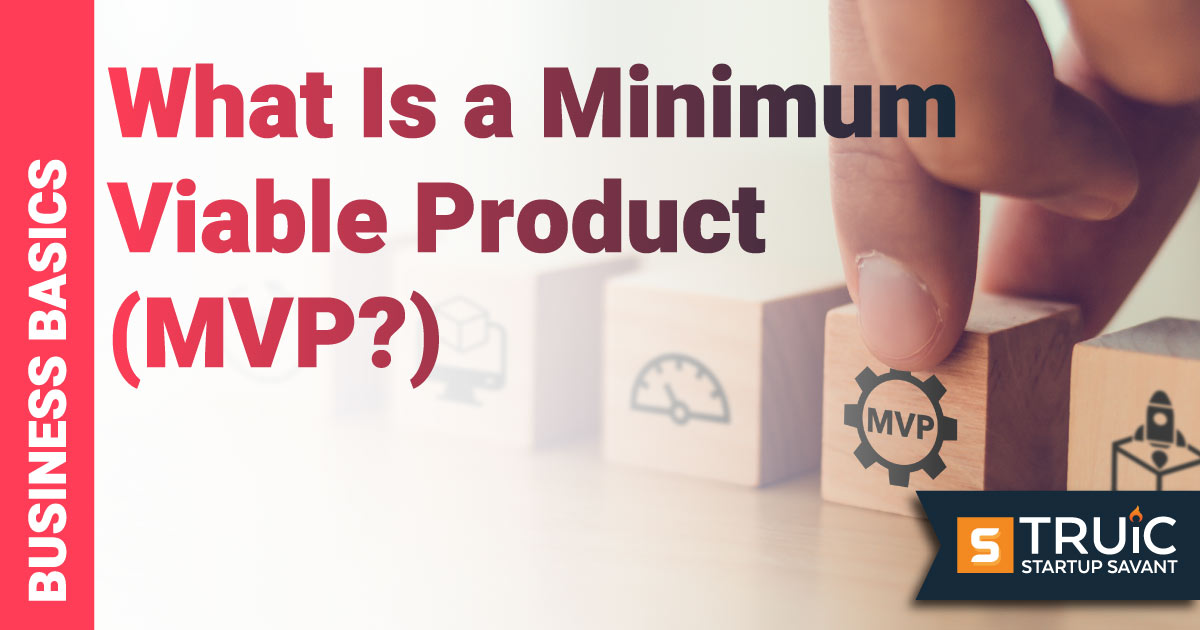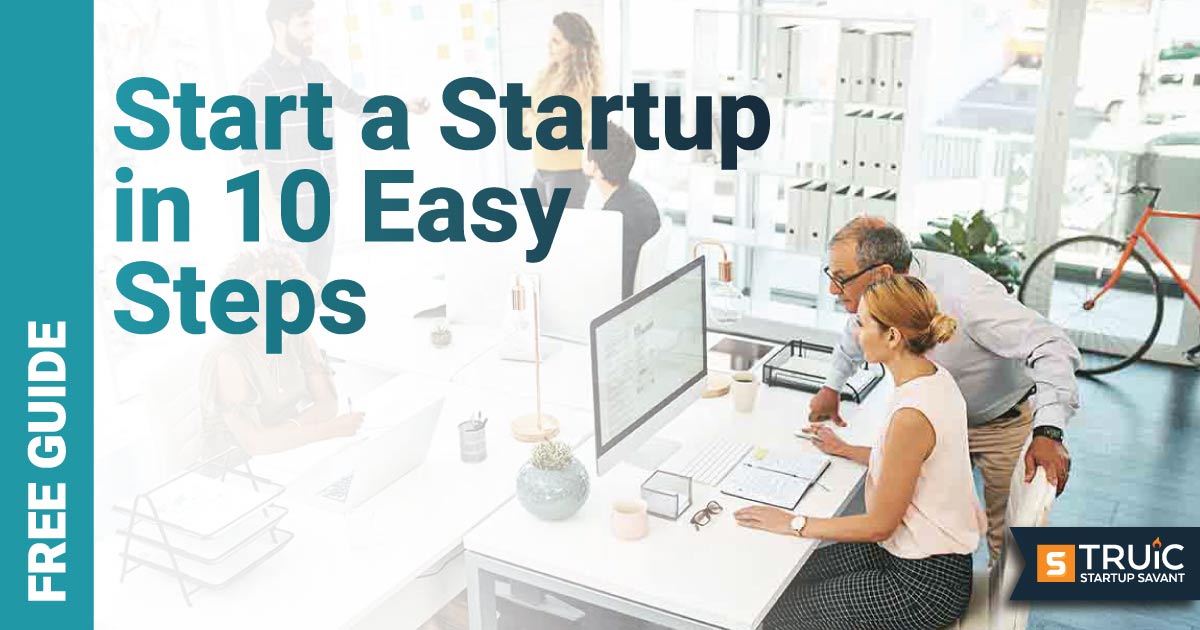What Is a Minimum Viable Product (MVP)?

Last Updated: By TRUiC Team
One phrase they love to use in the startup world is minimum viable product (MVP). You’ve probably heard this term many times. But, do you really understand what it means?
This article defines what an MVP is, examples of MVPs, and how you can build your own.
Skip Ahead:
What Is an MVP?
A minimum viable product (MVP), is a product or service that has just enough basic features to attract some early-adopting users in order to validate a product idea as quickly and easily as possible. Minimum viable products are just that, minimal. They have minimal functionality, but they provide the opportunity to see if customers are actually interested in using or purchasing a product or service.
The MVP concept was made popular by the lean startup methodology, and it underscores the need for (and impact of) learning during the new product development cycle. Not only can you validate that customers will actually use or purchase your product or service, but it also gives you the opportunity to collect invaluable feedback during the early days of the development process.
The key goal behind the MVP is to produce an actual product or service that you can “offer” to your target market. This allows you to gather feedback and create a product with product-market fit.
Purposes of an MVP
There are several reasons why startups and established companies alike may want to (and often should) create an MVP.
Let’s talk about some of the most cited reasons:
1. To Learn
The number-one purpose of launching a minimum viable product is to learn. Whether you want to learn about your audience or learn if your target customers will even want your product or service, an MVP is a tangible way to gather knowledge.
“A minimum viable product is a version of a new product which allows a team to collect the maximum amount of validated learning about customers with the least effort.” — Eric Ries
According to Eric Ries, creating an MVP jump-starts the build-measure-learn feedback loop, which is at the heart of the lean startup approach. Creating an MPV gives you the ability to get your product ideas into the hands of actual customers, gather feedback, observe them using it, and ultimately learn more.
2. To Minimize Costs
Many businesses launch minimum viable products to help minimize the costs of launching a product or service. This is particularly appealing for a startup or early-stage company that does not have the resources to launch a full-scale product.
Developing a “final” or “complete” product or service might take years and can be extremely costly. Building an MVP minimizes the time and resources that it would take to validate a business model without having to invest in developing a final or completed product.
By creating an MVP, new and young companies can test business hypotheses even with a minimal budget, allowing them to gain traction, begin to scale, spread out their costs over time, and raise capital to fund further growth.
3. To Release a Product Quickly
Another reason many companies launch a minimum viable product is to release a product to the market quickly. It takes far less time to create a product or service with limited functionality than it does a final one. Building an MVP speeds up the launch of a product or service significantly, allowing you to validate your business ideas, collect feedback, and begin building a customer base.
A quick release also allows you to engage early adopters in your target audience in the initial stages of development, providing you with the opportunity to collect invaluable feedback and align product development with your users’ wants and needs.
Benefits of an MVP
If you haven't figured it out by now, there are several benefits to building a minimum viable product. In addition to learning, minimizing costs, and releasing your product or service quickly, building an MVP allows a company to find the right audience, and balance product development with customer needs.
Validate Your Idea
One highly cited reason that startups and established companies build minimum viable products is to validate their product and service ideas. No one wants to invest resources into building a product and then find out that nobody wants it. Thus, many companies build MVPs to test their ideas with real customers before investing in developing a “full” or “complete” product or service.
Building an MVP allows you to “offer” your products or services to your target market and provides you the opportunity to find out if they even want it at all.
Find the Right Audience
Building an MVP also provides you the opportunity to find the messaging and audience, and engage in customer development. By building and marketing an MVP, you can test what messaging resonates with your target market and find the niches within your target audience that might be your early adopters and, most likely, customers.
Emphasize Core Features and Development
Building an MVP helps you focus on your important features and their development, as opposed to worrying about building others that might be nice to have but are not essential to your underlying solution. This encourages you to hold off on developing additional features outside of your core solution until your MVP proves successful with first customers.
Collect Invaluable Feedback
Beginning with an MVP also allows you to collect invaluable feedback to direct product development. Customer feedback is a must when you are developing a new product or service. Customer feedback helps you understand customers’ problems and pain points and helps you develop your solution to meet their wants and needs better.
By launching an MVP, you can familiarize yourself with who your customers are, observe how they use and interact with your product or service, and learn how to better solve the problems for which they are seeking solutions.
Collecting feedback can also tell you what to focus on next. What would be most beneficial for your users or customers? What elements might they not need at all?
Early Testing of Your Product or Service
Building an MVP allows you to begin testing your product or service early. An MVP gives you the opportunity to observe and test how customers or users interact with your product or service.
Depending on the type of MVP you build, you can test your messaging, pricing, desired features, and even the technological parts of your product or service. In application and software development, this is especially important, as a prototype may show how things should work. Only through quality control and testing with actual users will you find out if and how things actually work. Testing an MVP is also much more simple than testing a complex product or service.
Reduce Errors and Risk
Another benefit of building an MVP is to test your ideas and your early product or service in order to reduce the number of errors and risks. When you launch a minimal product, you can identify who your early and most active users are, how they use your product, and how you need to develop your product or service to meet their needs.
If you start off by building a complex product or service, there are many more moving parts, and it is much more difficult to find and correct errors, make changes, and tailor your product or service into a product that your customers want, need, and are willing to pay for.
Building an MVP with minimum features also simplifies everything in the process, generating far less risk than building a complex product or service with more to go wrong.
Examples of Successful Minimum Viable Products
There are many real-life examples of successful MVPs. Here are a few companies that started as a Minimum Viable Product:
Airbnb
Airbnb’s start may be described as purely coincidental. Needing help paying rent, Brian Chesky, Nathan Blecharczyk, and Joe Gebbia, the founders of Airbnb, used their own living room to make a few bucks and validate their idea that people could rent their extra space to those looking for short-term rental housing. They built a simple website, posted a few photos along with some additional details about the space, and had three paying guests by the next day. With their validated idea, they went to work building what has become the largest accommodation service in the world.
Dropbox
Another famous example of a successful minimum viable product is Dropbox. Dropbox launched their MVP as a short, three-minute explainer video that discussed how Dropbox would work and a link to a website at the end where users could leave their email address to stay updated. Without a working product, founders Drew Houston and Arash Ferdowsi wanted to make sure that potential users would even be interested in their file-syncing idea before they built it. It turns out they were, as more than 70,000 people had signed up for the mailing list by the next day.
Buffer
Before Buffer developed its social media sharing applications, it began as a simple landing page. Buffer’s landing page explained what Buffer was and how it works. Buffer then offered several plans and a sign up button, all without even developing a product. For those who were interested, when they attempted to sign up, they were shown a message that Buffer wasn’t quite ready but encouraged them to sign up for updates. With email addresses in hand, Buffer used these to have actual conversations with interested users in order to gain insights to build a product that they actually wanted.
Spotify
Spotify is a great example of a company that focused on a single-feature MVP. Back in 2006, when founders Daniel Ek and Martin Lorentzon came up with the idea for Spotify, there were few options for streaming music. Wanting to get to market quickly, Ek and Lorentzon focused on a single feature when building their MVP — the ability to stream music. They built their MVP, a desktop application, in just four months and by 2007 began beta testing with influential music bloggers in Sweden. 15 years later, Spotify has over 300 million active monthly users and over 170 million premium users.
“We spent an insane amount of time focusing on latency when no one cared because we were hell-bent on making it feel like you had all the world’s music on your hard drive. Obsessing over small details can sometimes make all the difference. That’s what I believe is the biggest misunderstanding about the minimum viable product concept. That is the V in the MVP.” — Daniel Ek, founder of Spotify
How to Build an MVP
Step 1: Research the Market
The first step in building a minimum viable product is to research your business idea. Before beginning to build anything, you should research the industry, research the market, and research the competition.
In order to create a successful product or service, your idea needs to meet the needs of the market. It needs to solve an actual problem that your target market has, and your target market needs to be willing to pay for your product or service.
No matter how “cool” your concept is, if your target audience doesn’t want or need it and they are not willing to pay for it, you probably shouldn’t be building an MVP in the first place. According to one recent survey by CBInsights, a lack of market need is one of the top reasons startups fail.
To avoid facing the problem of building a product no one wants or needs, research your market. This may include studying research that already exists, such as government data, industry reports, and trade publications or it may involve conducting your own research like surveys and customer interviews with those who you believe might be your most likely potential customers.
You should also spend some time researching your competitors. Although you may believe your product or service is unique, chances are your target market is solving the problem that your solution intends to solve in some way or another.
Step 2: Develop Your Idea
The next step in building an MVP is to identify definitive areas of the market where your product or service can solve specific problems or improve upon current solutions.
You can start by asking yourself, “what problems is my business idea solving,” but to successfully complete this step, you really need to understand your target market and take on their perspective.
What problems or pain points are most important to your target market? And, why and how would your target market use your solution?
With a better understanding of a specific problem facing your target market, you can begin developing your idea around the key features that will solve these problems. This will ensure that your MVP is actually viable.
Step 3: Define Your Features
You can begin by listing all the features that your product or service “must have” as well as all of the ones that would be nice to have.
Then you will need to prioritize these features. Remember that you can only create a limited amount of functionality for your minimum viable product. But, it also needs to be viable. You will need to determine which ones are necessary and which ones you may want to add down the road.
By listing and prioritizing the product features, you are translating these priorities into an action plan. Your MVP needs to include, and only include, just enough features that are necessary for making your product viable.
Step 4: Build and Launch
After all of your research and due diligence, the next step in building a minimum viable product is to actually build and launch the MVP.
How you go about building and launching an MVP depends on what type of MVP you decide to begin with. The ultimate goal is to achieve validated learning as you iterate toward a solution that solves your customers’ problems efficiently.
Many startups begin with a low-fidelity MVP to validate whether there are enough customers that would be interested in buying their product or service and then launch a high-fidelity MVP to validate that their solutions are actually solving their customers’ problems.
Step 5: Measure, Learn, and Iterate
The “final” step in building an MVP is measuring, learning, and iterating. During this phase, you will begin measuring the results from your launch.
So what should you measure? The short answer is everything you can. Metrics like traffic, conversions, sales metrics, customer acquisition costs, and average revenue per user may all be useful for your business growth.
With data in hand, you should focus on learning from it. Try to determine:
- Will it be profitable to continue developing your idea?
- Should you pivot?
- Are you solving your customers' problems?
- What market should you focus on?
- Who are your best customers?
- What features should you focus on next?
Another part of learning is going right to your customers to get user feedback. There are many different ways to collect feedback from your customers. One of the best ways to collect feedback is to ask your early adopters to fill out a survey or sit down for an interview.
In many cases, such as software development, this part of the process will continue through the lifecycle of your product or service. Through proof of concepts, prototypes, alpha releases, beta releases, and versions 1.0 to 99.9 will all require you to build, measure, learn, and iterate.
Recommended: Looking for some extra resources? Check out our list of the top MVP development companies.
The MVP Glossary
Exceptionally Viable Product (EVP): a version of your MVP that is close to the final product.
High-Fidelity MVP: an MVP in which you actually build a version of the product or service.
Low-Fidelity MVP: an MVP that does not yet have a functional product or service.
Minimum Lovable Product (MLP): an MVP that provides your audience with a user experience they love.
Minimum Marketable Features (MMF): This refers to a group of features that offers the smallest amount of functionality a product or service needs in order to appeal to the market.
Minimum Marketable Product (MMP): a product with the minimum marketable features to be appealing to consumers.
Proof of Concept: an activity focused on determining if a business idea is feasible (e.g., can it be done from a technology standpoint, a financial standpoint, etc.).
Prototype: a prototype is an early simulation or model of a product or service used to test a concept.
Single-Feature MVP: An MVP developed around a single core feature that users need.
Frequently Asked Questions
What is the MVP approach?
The MVP approach is an approach to new product development that focuses on creating a minimum viable product, getting it into the hands of buyers, collecting feedback, and developing your final one (or pivoting) based on your customer’s wants and needs.
Where did MVP originate?
The term MVP originated in the lean startup methodology popularized by Eric Ries in his book ‘The Lean Startup.’ This, along with Steve Blank and several other proponents in the early 2010s, brought the MVP model to prominence.
What is the difference between MVP vs. proof of concept?
The difference between an MVP and a proof of concept is that although an MVP helps to prove your concept, a proof of concept only looks to prove the feasibility of an idea, not how your customers will react to it. Proof of concepts are conducted to determine whether your idea is feasible and if you should build an MVP at all.
What is the difference between a minimum viable product (MVP) vs. a prototype?
The difference between an MVP and a prototype is that while both are minimal versions of a product or service, a prototype is about exploring ideas and what a final product could be, while minimum viable products are about showing the viability of the idea and the problem you are trying to solve. An MVP is a form of prototype. It is just one that is further along in the development process.
What is the difference between an MVP vs. minimum marketable features?
The difference between an MVP and MMF is what makes an MVP viable might not make it marketable. An MVP contains the minimum amount of features that are viable to solve a customer or user’s problem, but it may not have the minimum features to be a marketable product. MVPs are built in order to learn enough to create a product with minimum marketable features (a minimum marketable product or MMP).


